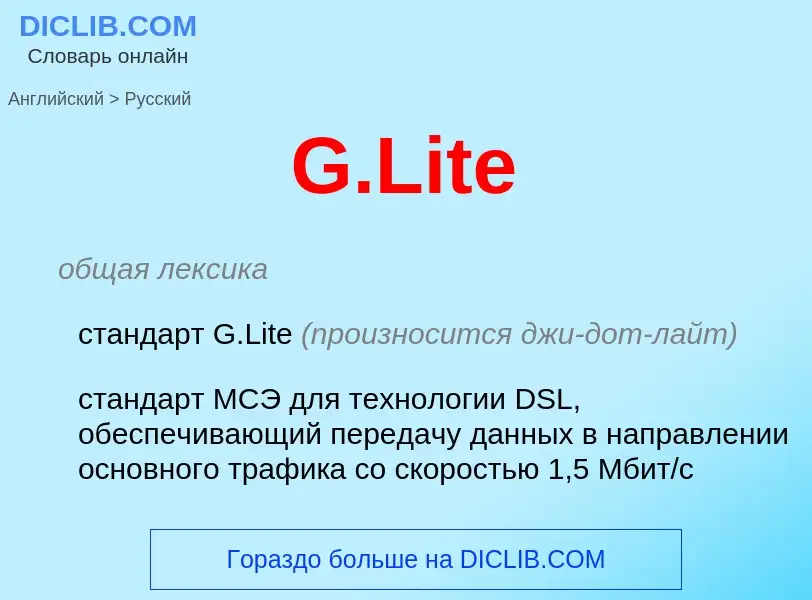Перевод и анализ слов искусственным интеллектом ChatGPT
На этой странице Вы можете получить подробный анализ слова или словосочетания, произведенный с помощью лучшей на сегодняшний день технологии искусственного интеллекта:
- как употребляется слово
- частота употребления
- используется оно чаще в устной или письменной речи
- варианты перевода слова
- примеры употребления (несколько фраз с переводом)
- этимология
ADSL Lite - перевод на
общая лексика
стандарт G.Lite (произносится джи-дот-лайт)
стандарт МСЭ для технологии DSL, обеспечивающий передачу данных в направлении основного трафика со скоростью 1,5 Мбит/с
Смотрите также
общая лексика
Asymmetrical Digital Subscriber Line, Asymmetrical DSL
асимметричная цифровая абонентская линия, асимметричная DSL
развитие технологии HDSL (одной из четырех технологий DSL). Ответ телефонных компаний на появление кабельных модемов (cable modem). Технология высокоскоростной передачи данных по обычным телефонным линиям (к пользователю со скоростью от 1,5 до 9 Мбит/с, от него - 640 кбит/с) на расстояние до 5,5 км. Возможны передача данных и телефонное соединение одновременно. В будущем скорости ADSL могут быть четырёхкратно увеличены
Определение
Википедия
In telecommunications, ITU G.992.2 (better known as G.lite) is an ITU standard for ADSL using discrete multitone modulation. G.lite does not strictly require the use of DSL filters, but like all variants of ADSL generally functions better with splitters.
G.lite is a modulation profile which can be selected on a DSLAM port by an ADSL provider and provides greater resistance to noise and tolerates longer loop lengths (DSLAM to customer distances) for a given bandwidth. Most ADSL modems and DSLAM ports support it, but it is not a typical default configuration. The transmission speed of G.lite (G.992.2) is 1.5 Mbit/s downstream and 512 kbit/s upstream.
The G.lite specification was an accelerated ITU-T effort to drive interoperability among vendors and was facilitated by the Universal ADSL Working Group, or UAWG. The G.lite standardization effort took a total of 11 months from start to finish, setting a new record for ANY standard effort within the ITU-T. The previous record had been the V.90 specification for analog modems, which took 18 months to complete. The UAWG consisted of three sets of members: Promoters, Supporters and Adopters. Intel, Compaq and Microsoft were able to rally the support of all of the US RBOCs and five of the largest international carriers (NTT, British Telecom, France Telecom, Deutsche Telekom, and Singapore Telecom), collectively representing the Promoters, to drive the major communications equipment manufacturers (the Supporters) to demonstrate interoperability of products based on the G.lite specification at SUPERCOMM in June 1999. Adopters represented the majority of the remaining companies in the communications industry that were committed to supporting the new technology specification.

.jpg?width=200)
![[[Frequency spectrum]] of modem on ADSL line [[Frequency spectrum]] of modem on ADSL line](https://commons.wikimedia.org/wiki/Special:FilePath/ADSL spectrum Fritz Box Fon WLAN.png?width=200)
![SoC]] SoC]]](https://commons.wikimedia.org/wiki/Special:FilePath/Lantiq XWAY VRX288 V1.1.png?width=200)
